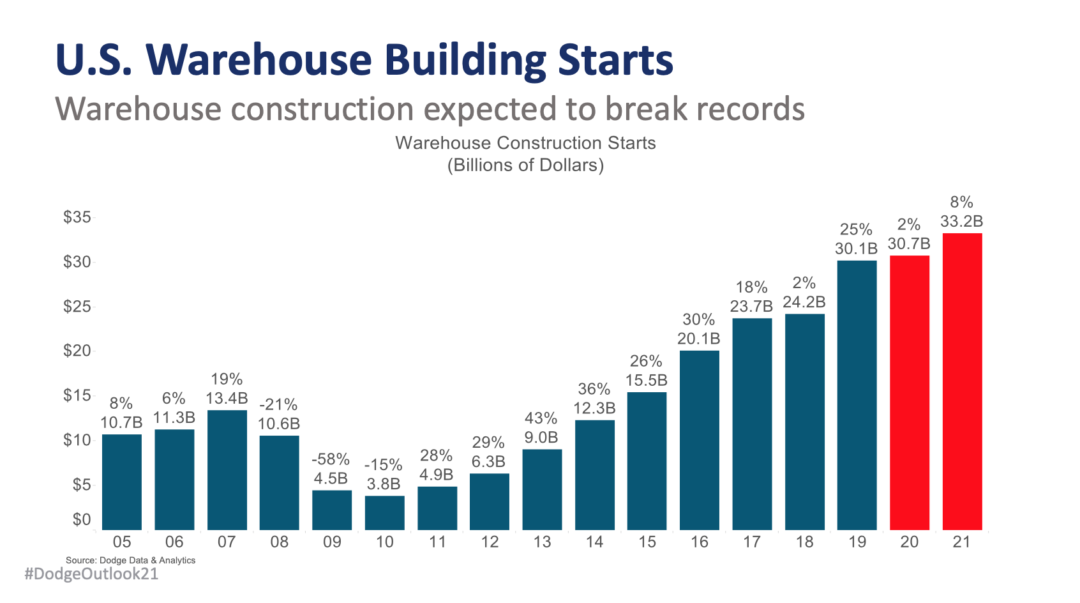Full economic rebound will rely on Covid vaccine, second stimulus bill, Dodge and JLL warn.

Investors have shelved billions of dollars in construction projects since the Covid-19 pandemic and recession began in February, but the logistics sector has largely bucked that trend as companies continue to push a surge in new warehouse creation to handle booming e-commerce demand, according to a pair of studies released this week.
Counting all types of construction nationwide, builders doubled the value of projects they launched between the depths of the 2009 recession and the pre-Covid market peak in 2019, topping out last year at $853 billion worth of single family and multifamily housing, commercial projects, institutional building, manufacturing plants, public works, and electric power/utility sites.
The coronavirus stopped that trend abruptly, however, pushing the overall construction market into a steep decline that is forecast to tumble 14% in 2020 to $738 billion, according to “Dodge Construction Outlook 2021: Moving Forward on the Road to Recovery,” an economic report produced by New Jersey-based Dodge Data & Analytics, a market forecasting firm in the commercial construction sector.
But one exception stands out amid that sea of red ink, as warehouse starts are still expected to grow in 2020. Dodge defines warehouses as part of the larger “commercial” construction segment—alongside stores, offices, hotels, and parking garages—which is expected to fall 23% to $107 billion in 2020 before rebounding in 2021 with a 5% rise to $113 billion.
Likewise, a second report also found signs of a nascent economic recovery in logistics despite significant negative impacts on the retail and hospitality industries, which are particularly reliant on consumer spending and mobility, according to the latest “Global Real Estate Perspective” report from real restate firm Jones Lang LaSalle IP Inc. (JLL).
More specifically, warehouse growth is seeing spikes in certain specialty areas, such as an increase in last-mile logistics facilities as online retail grows, the conversion of retail facilities into logistics facilities in dense urban areas, and demand for cold-storage in the food & beverage and life sciences sectors. “Demand for logistics space has bounced back sharply, hitting record or near-record levels in several major global markets during the quarter. E-commerce companies have been particularly active, supported by increased consumer demand for online shopping,” the JLL report said.
Despite that optimism, the 2021 economic rebound could be delayed until later in the year if certain variables don’t line up, the Dodge report said. “Prospects for recovery in 2021 will be limited until a vaccine has been approved and has been widely adopted, a process that is expected to begin by mid-2021. The uncertainty surrounding further federal stimulus and growing budget gaps at state and local levels, however, cloud the outlook,” said report author Richard Branch, Dodge’s chief economist.
U.S. economy awaits second round of stimulus funds
Another wild card in the recovery will be federal stimulus funding, which made a significant impact on the economy beginning in March, when Congress passed the $1.7 trillion CARES Act—an acronym for Coronavirus Aid, Relief, and Economic Security—including the Paycheck Protection Program (PPP) and other loans and grants. That effect was temporary, however, as the fiscal boost provided by the CARES Act began to fade after income support programs within the act expired in July and the PPP ended in August, Dodge said.
The prospects for quick passage of a second large stimulus package now seem dim, based on November 4 election results that have split federal government control between a Democratic Biden Administration and House of Representatives and a Republican Senate. “Without the help provided by CARES funding, the economy is unlikely to regain significant forward traction until a vaccine has been approved and widely adopted across the United States,” the Dodge report found.
In the longer term, the researchers expect an additional $1.5 trillion of stimulus to be approved in the first quarter of 2021, helping the economy return to stronger growth in the second quarter of 2021. Yet even when that recovery occurs, the impact of the pandemic could have long-lasting implications for the retail industry, changing many of the supply chain patterns that have stood for decades, thanks to the closing of thousands of retail stores that failed to survive the recession.
“While brick and mortar is unlikely to disappear entirely, online shopping became a much more ingrained part of consumer purchasing behavior due to stay-at-home orders,” the Dodge report said. “A massive number of consumers clearly turned to online shopping to deal with the restrictions of Covid-19 in the second quarter. If this sea change in consumer behavior becomes a permanent phenomenon, the long-lasting effects of Covid-19 could mean further deterioration in retail construction starts in coming years.”
Despite the impact of those trends on retail stores, the accompanying rise in e-commerce has been good news for the warehouse construction needed to provide fulfillment for all those online orders.
Beginning at a low point of just 49 million square feet in 2010, warehouse starts increased by double-digit rates for seven consecutive years, resulting in an “amazing” 508% increase that brought starts up to 297 million square feet in 2017, the firm said. After a flat period in 2018, the hot curve resumed with 354 million square feet in 2019, and is forecast to resume that growth in 2021 with post-Covid projects led by a growing number of million-square-foot mega-warehouses built by amazon.com.
